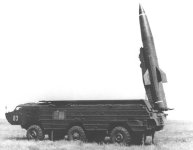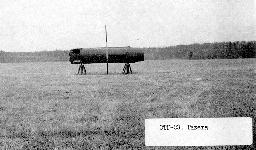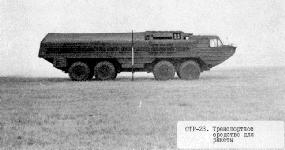




In the early 1970s, the Soviet Army sought a replacement for the 9K72 Elbrus (SS-1C `Scud B') system, which had a very slow reaction time [around 90 minutes to prepare and fire] and its poor accuracy when using conventional warheads. The replacement system, codename 9K714 Oka, was developed by KB Mashinostroyenia (Machine Industry Design Bureau) in Kolomna. The new 9K714 system featured a reaction time of under 30 minutes and used the low-maintenance solid-fuel 9M714 missile. The 300 km range of the R-300 (`Scud') was surpassed by the 400 km range of the 9M714/R-400.
In the early 1970s the Warsaw Pact had only a limited ability to strike North Atlantic Treaty Organization (NATO) air bases in Europe. However, by the mid-1980s Soviet forces could strike NATO airfields in all types of weather using tactical ballistic missiles (TBMS) such as the SS-21 and the SS-23. NATO had only limited defense against these weapons, some of which were accurate to within 100 meters. The SS-23 has a range of 310 miles, with speeds of 6,800 miles per hour or Mach 9 that can access most locations in a given theater of war.
The Intermediate-Range and Shorter-Range Nuclear Forces [INF] Treaty was signed on 08 December 1987 and entered into force on 01 June 1988. The fundamental purpose of the INF Treaty was to eliminate and ban US and former USSR (FSU) ground-launched ballistic and cruise missiles, as well as associated support equipment, with ranges between 500 and 5500 kilometers. SS-12 and SS-23 transporter-erector-launcher (TEL) vehicles were eliminated at Stan'kovo.
On 21 July 1988, US Army Colonel Edward H. Cabaniss led an American INF inspection team to Petropavlovsk in Kazakhstan, approximately 2,000 kilometers east of Moscow. Petropavlovsk was the location of the V.I. Lenin Heavy Machine Building Plant, where the American team conducted a closeout inspection of the former SS-23 missile launcher production facility. The last of 239 SS-23 missiles was destroyed at the Saryozek Missile Elimination Facility on 27 October 1989. The final SS-23 launcher was eliminated the same day at the Stan'kovo Elimination Facility. The Soviet Union had negotiated separate diplomatic agreements with both Czechoslovakia and the German Democratic Republic, where Soviet INF missile units had been based. In the case of the INF Treaty, the Soviet-declared data was not agreed to by each side, and it was not included in the Treaty. Later it turned out that the Soviets had falsified some of their INF data. In April of 1990 the Soviets admitted that they had covertly provided SS-23 missiles banned by the INF Treaty to three East European nations. At least 120 Soviet-controlled SS-23s covertly deployed in Eastern Europe, which the US INF negotiator termed "deceit and mendacity" during the negotiations. In February 1990 President Bush sent Congress a report stating that the Soviet SS-23 deployment did constitute "bad faith." But he didn't say whether it was a violation of the INF Treaty. The State Department was embarrassed by the discovery later that some Soviet-declared INF data was false, because the State Department had repeatedly vouched for its accuracy in public when advocating the Treaty.


